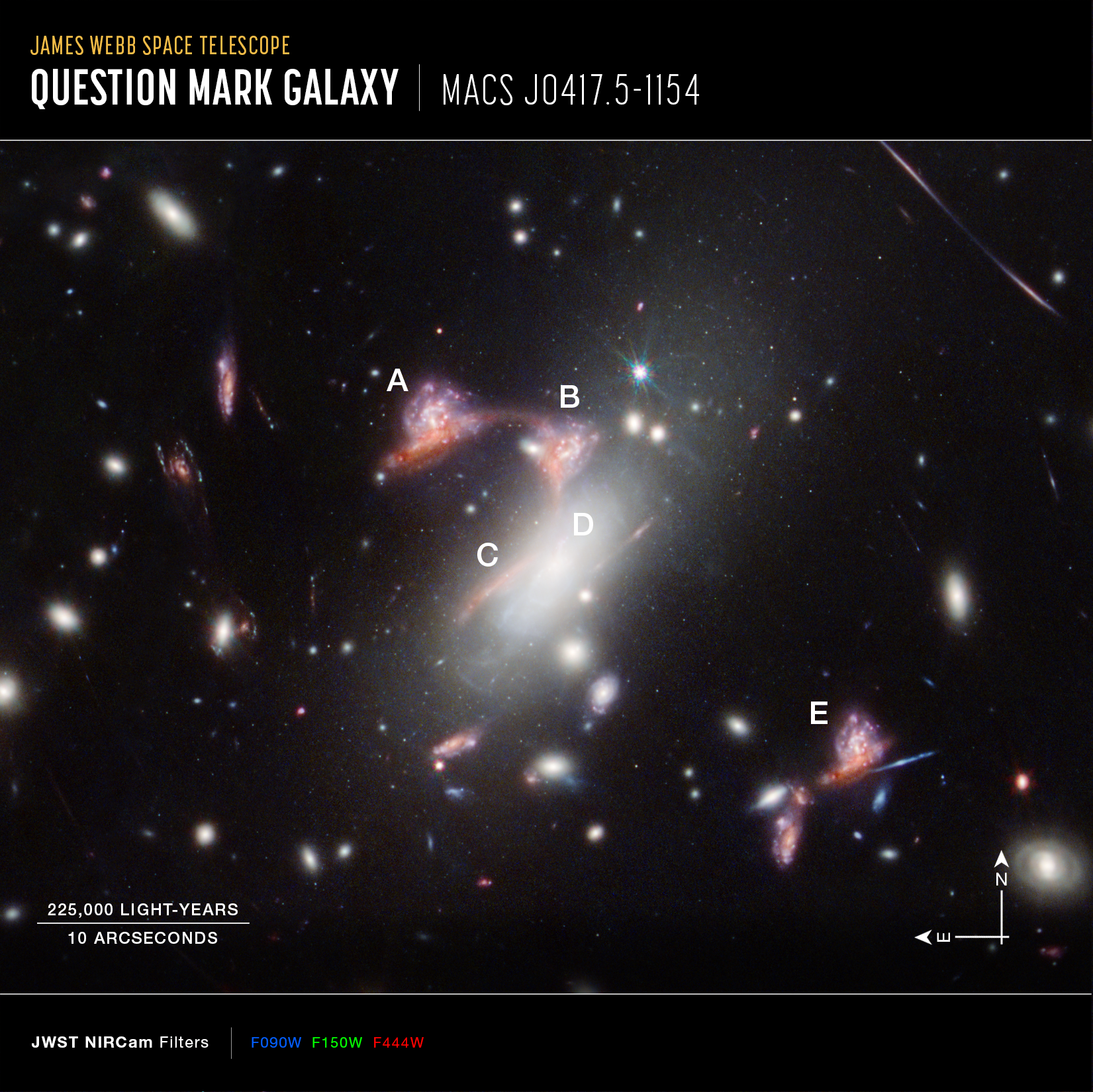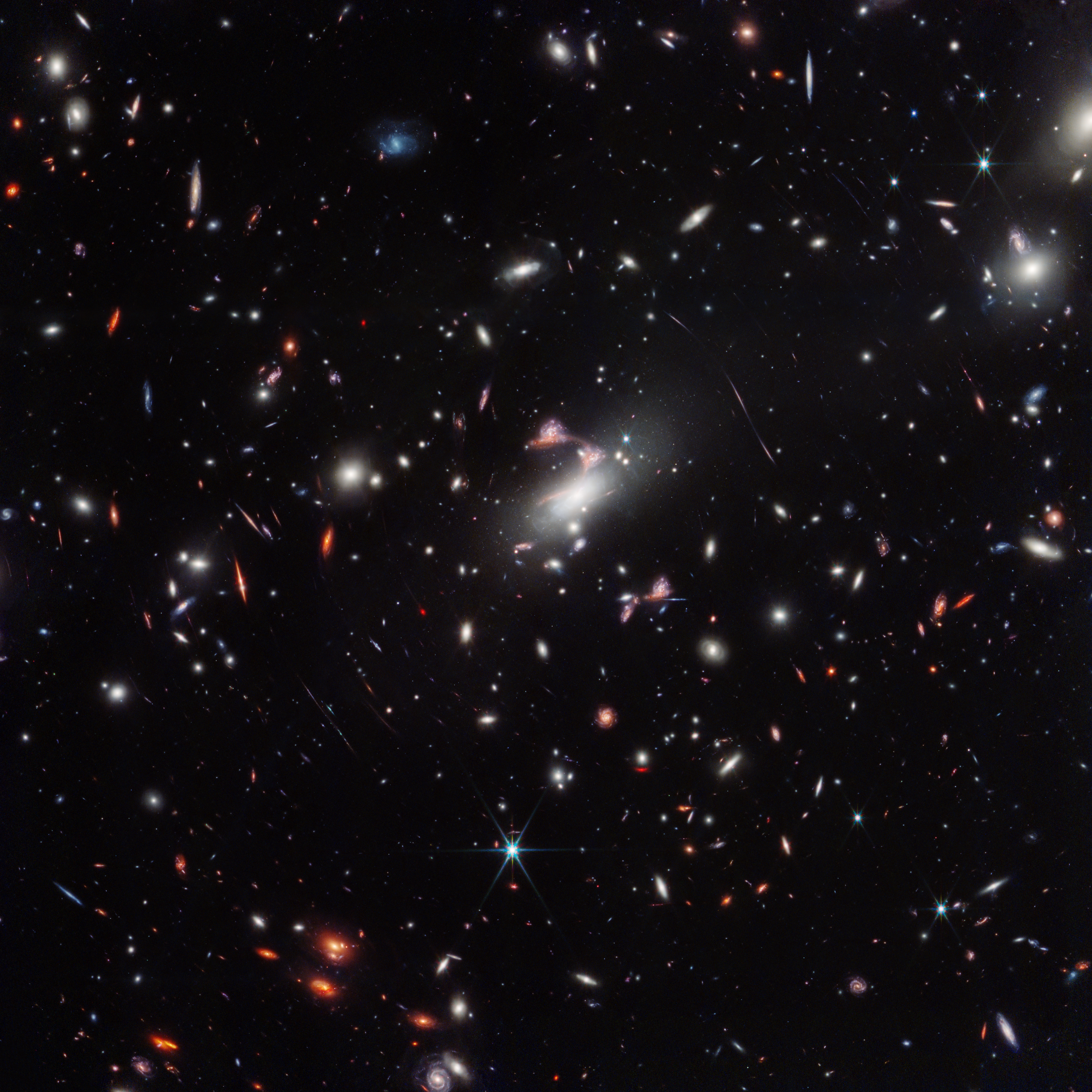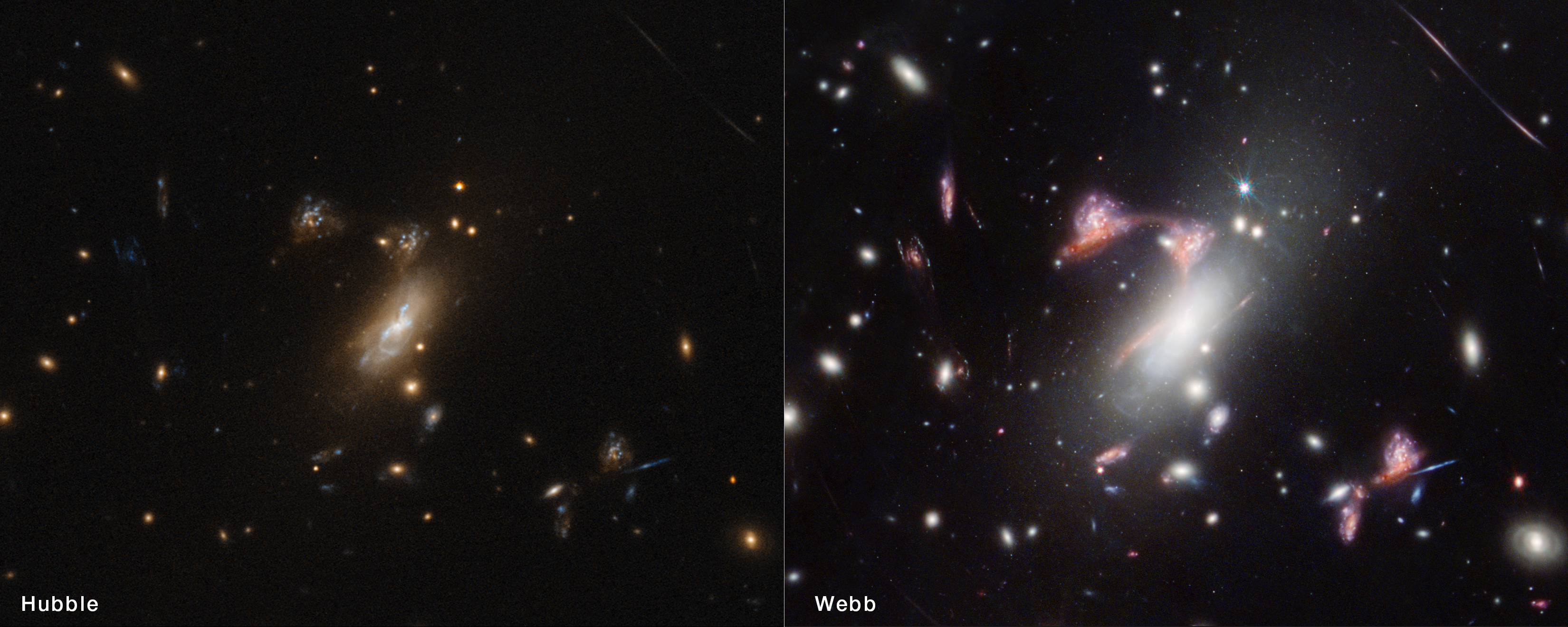1 min read
Question Mark Galaxy, Annotated (NIRCam Compass Image)

A specific type of gravitational lensing known to astronomers as hyperbolic umbilic, captured in the James Webb Space Telescope’s image of galaxy cluster MACS-J0417.5, results in the optical illusion of five multiples of one distant galaxy pair, labeled here as A, B, C, D, and E. While the pair exists once in reality, it appears five times when viewed through the funhouse mirror of warped space created by the mass of the cluster. Image D is largely obscured behind the bright white glare of one of the cluster galaxies.
This image also includes compass arrows, scale bar, and color key for reference. The scale bar is labeled in arcseconds, which is a measure of angular distance on the sky. There are 60 arcminutes in a degree and 60 arcseconds in an arcminute. (The full Moon has an angular diameter of about 30 arcminutes.) The actual size of an object that covers one arcsecond on the sky depends on its distance from the telescope.
This image shows infrared wavelengths of light that have been translated into visible-light colors. The color key at the bottom of the image shows which filters from Webb’s NIRCam (Near-Infrared Camera) instrument were used. The color of each filter name is the visible light color assigned to represent the infrared light detected by that filter.
Extended Description and Image Alt Text
Extended Description
Amid a field of galaxies, five repeat images of a galaxy pair are labeled with letters of the alphabet. A, B, and C trace the shape of the top of a question mark, curving from left to right and then down. To the right of this shape is the letter D, but the galaxy pair is largely washed out by a bright white, oval foreground galaxy. The E label and galaxy pair are at a greater distance to the lower right.
At the bottom right are compass arrows indicating the orientation of the image on the sky. The east arrow points toward 9 o’clock. The north arrow points in the 12 o’clock direction. At the bottom right is a scale bar labeled 2 arcseconds The length of the scale bar is about one sixth of the total image. Below the image is a color key showing which filters were used to create the image and which visible-light color is assigned to each filter. NIRCam filters from left to right: F090W, in blue; F150W, in green; F444W, in red.
Image Alt Text
Image titled “James Webb Space Telescope, Question Mark Galaxy, MACSJ0417.5-1154” with letter labeling, compass arrows, scale bar, and color key. See extended description for more.
About the Object
- R.A. PositionR.A. PositionRight ascension – analogous to longitude – is one component of an object's position.04:17:34.6
- Dec. PositionDec. PositionDeclination – analogous to latitude – is one component of an object's position.-11:54:32
- ConstellationConstellationOne of 88 recognized regions of the celestial sphere in which the object appears.Eridanus
- DistanceDistanceThe physical distance from Earth to the astronomical object. Distances within our solar system are usually measured in Astronomical Units (AU). Distances between stars are usually measured in light-years. Interstellar distances can also be measured in parsecs.4.65 billion light-years (z=0.441)
- DimensionsDimensionsThe physical size of the object or the apparent angle it subtends on the sky.Image is about 50 arcseconds across (about 1.2 million light-years)
About the Data
- Data DescriptionData DescriptionProposal: A description of the observations, their scientific justification, and the links to the data available in the science archive.
Science Team: The astronomers who planned the observations and analyzed the data. "PI" refers to the Principal Investigator.This image was created with Webb data from proposal: 1208 (C. Willott); Image Processing: Joseph DePasquale (STScI)
- InstrumentInstrumentThe science instrument used to produce the data.NIRCam
- Exposure DatesExposure DatesThe date(s) that the telescope made its observations and the total exposure time.Oct 2022
- FiltersFiltersThe camera filters that were used in the science observations.F090W, F150W, F444W
- Object NameObject NameA name or catalog number that astronomers use to identify an astronomical object.Question Mark Galaxy in MACS J0417.5-1154
- Object DescriptionObject DescriptionThe type of astronomical object.Gravitationally lensed galaxy in galaxy cluster
- Release DateSeptember 4, 2024
- Science ReleaseNASA’s Webb Reveals Distorted Galaxy Forming Cosmic Question Mark
- CreditImage: NASA, ESA, CSA, STScI, Vicente Estrada-Carpenter (Saint Mary's University)

These images are a composite of separate exposures acquired by the James Webb Space Telescope using the NIRCam instrument. Several filters were used to sample wide wavelength ranges. The color results from assigning different hues (colors) to each monochromatic (grayscale) image associated with an individual filter. In this case, the assigned colors are: Blue: F090W Green: F150W Red: F444W
Related Images & Videos

Question Mark Galaxy (NIRCam Image)
The galaxy cluster MACS-J0417.5-1154 is so massive it is warping the fabric of space-time and distorting the appearance of galaxies behind it, an effect known as gravitational lensing. This natural phenomenon magnifies distant galaxies and can also make them appear in an image...

MACS J0417.5-1154 Wide Field (NIRCam Image)
A cosmic question mark appears amid a powerful gravitational lens in the James Webb Space Telescope’s wide-field view of the galaxy cluster MACS-J0417.5-1154. Gravitational lensing occurs when something is so massive, like this galaxy cluster, that it warps the fabric of...

Question Mark Galaxy (Hubble and Webb Image)
NASA’s Hubble Space Telescope has also observed the galaxy cluster MACS-J0417.5-1154, but the dusty red galaxy that appears multiple times to form a question mark shape is much more prominent in the Webb image. The infrared light that Webb detects is better able to pass through...
Share
Details
Laura Betz
NASA’s Goddard Space Flight Center
Greenbelt, Maryland
laura.e.betz@nasa.gov
NASA, ESA, CSA, STScI, Vicente Estrada-Carpenter (Saint Mary’s University)






























